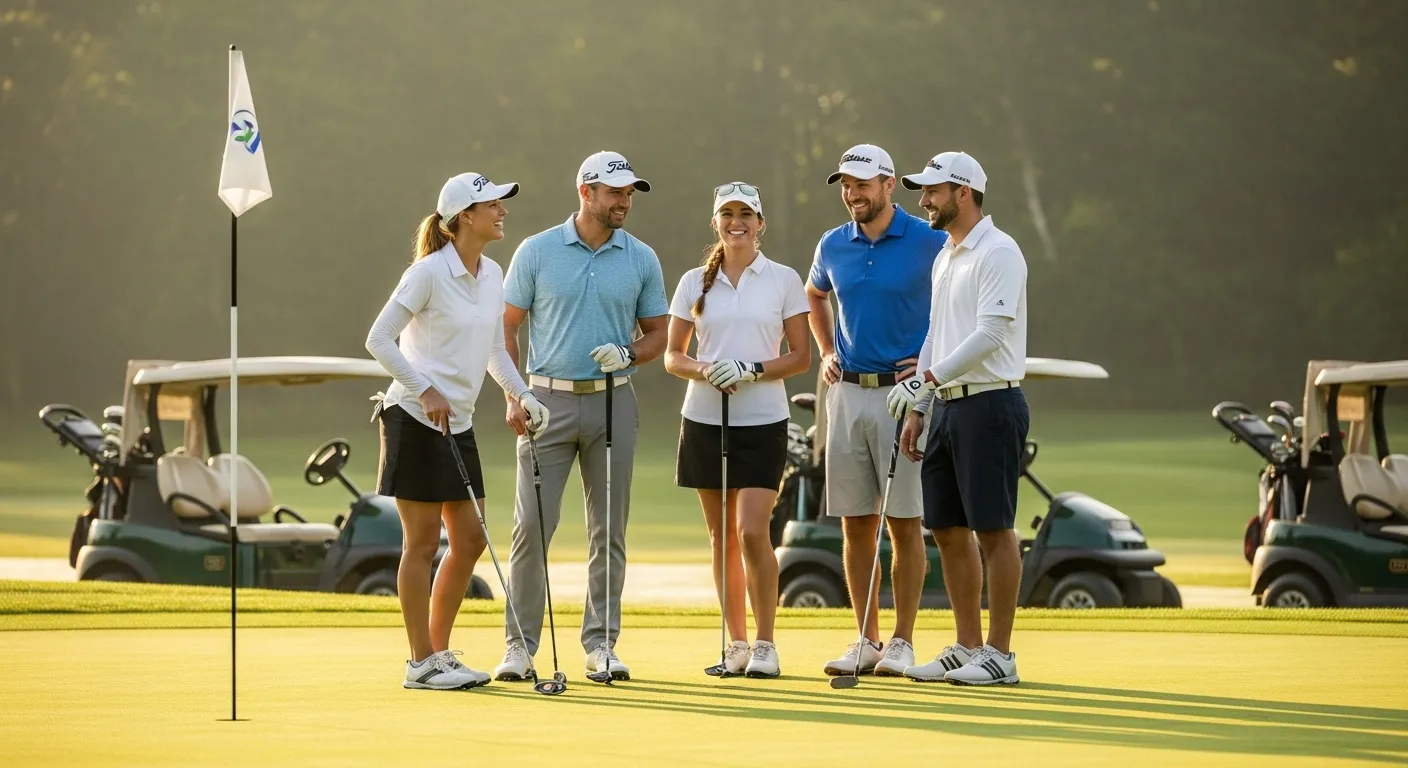If you’ve ever stood in front of a dartboard that just felt wrong—too high, too low, maybe a little crooked you already understand why dart board height matters more than most people think. I’ve seen players miss easy doubles for weeks because their board was off by a few centimeters. So let’s fix that.
We’ll review the correct installation, the way to determine the height from the ground to the bullseye, the proper dart throwing distance, and how to make your home setup look like it’s from a pub. No flashy stuff, no overly polished tips—simply the things that work.
Why Height Matters More Than You Think
The height of your dartboard isn’t just about “following the rules.” It’s about training muscle memory. If your board is off, your throw angle changes. That angle becomes a habit. And that habit? It’ll wreck your accuracy when you play anywhere else — league night, a friend’s house, even online competitions. For beginners, understanding the dartboard rules and setup is just as important as getting the height right.
A small difference, like hanging the board 5 cm too high, can shift your aim enough to make your darts drift off target every time.

Regulation Dart Board Height
Here’s the official standard:
| Measurement Type | Metric Value | Description |
| Dartboard Height | 1.73 m | From the floor to the center of the bullseye |
| Throwing Distance (Oche) | 2.37 m | From the front of the dartboard to the throw line |
| Diagonal (Floor to Bullseye) | 2.93 m | Used to double-check accuracy |
That 1.73 m height isn’t random—it’s the official regulation dartboard height used in professional tournaments worldwide.
Getting the Height Right (Without Guessing)
Skip the guesswork. You’ll need:
- A tape measure
- A pencil or marker
- A drill and mounting bracket (most bristle boards include one)
- A spirit level
The measurement between the ground and the center of the bullseye is 1.73 meters. It is highly recommended to write this point down — that’s the height of the dartboard you’ll use for mounting. When the board is hung, the bullseye should be positioned exactly at that point after you’ve secured the bracket. For more setup ideas and variations, check out this guide on dartboard rules and setup.
If you’re hanging it on drywall, use anchors. Bristle boards weigh several kilos; trust me, you don’t want that thing falling mid-game.
Dartboard Distance: The Throw Line (Oche)
The second measurement people mess up constantly—the throwing distance.
In metric terms, the dart throwing distance is 2.37 meters from the front face of the board to the oche, or throw line. Don’t measure from the wall—measure from the front surface of the dartboard. That few centimeters of thickness matters.
If your board’s mounted in a cabinet or has a deep frame, measure carefully. You can tape a string to the bullseye and pull it down to the floor to confirm the diagonal distance of 2.93 m—that’s the pro’s cross-check.
The Dartboard Setup at Home
Home setups don’t need to look like pubs. But they should feel consistent. Use bristle dartboards if possible (like Winmau or Unicorn brands). They self-heal and last much longer than cork or paper.
When talking about casual or electronic dartboards, the height may vary a little. In general, soft tip boards are placed a bit higher, approximately 1.78 m, but it really depends on the manufacturer’s specifications. So it is better to confirm with the guide as it is different from the steel tip board standard setup and measurements.
| Board Type | Height (Floor to Bullseye) | Throw Distance | Notes |
| Steel Tip (Bristle) | 1.73 m | 2.37 m | Official tournament standard |
| Soft Tip (Electronic) | 1.78 m | 2.44 m | Common for electronic boards |
| Kids / Beginner Setup | 1.5–1.6 m | 2.0 m | Optional for young players |

Common Mistakes in Dartboard Measurements
- Measuring from the wall. Wrong. Always from the board’s front.
- Not accounting for carpet or mats. Floor thickness can shift your 1.73 m by a bit.
- Mounting too low in a cabinet. Cabinets often lower the bullseye unless adjusted.
- Skipping the level check. Boards look fine to the eye but end up crooked—throws drift left or right.
That last one? Happens way too often. A slightly tilted board makes your triple 20 look like a moving target.
Quick Reference Table: Dartboard Measurements (Metric)
| Setup Element | Measurement (Meters) | Notes |
| Height (Bullseye) | 1.73 m | Regulation for adults |
| Oche Distance | 2.37 m | From board front to throw line |
| Diagonal | 2.93 m | Accuracy cross-check |
| Electronic Board Height | 1.78 m | Soft-tip boards only |
| Kids Setup Height | 1.5–1.6 m | Optional training setup |
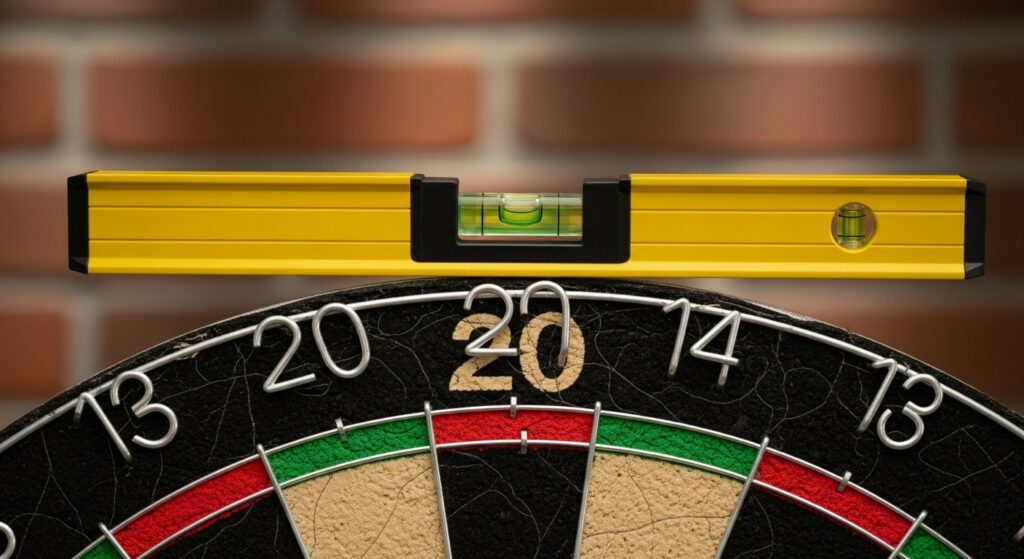
So the floor measurement you took was 1.73m, the bullseye is perfectly aligned, and the throwing line has been taped down at 2.37m. Fine. The issue is that the majority of people simply do not consider that next step, which is what makes a practical installation turn into a comfortable one.
If you’re aiming for a setup that feels professional and consistent, make sure your dartboard height and distance follow regulation standards. Getting these small details right not only improves accuracy but also ensures every throw feels natural.
Because if you plan to practice a few nights a week, those missed details (wall protection, lighting, dartboard angle, even floor surface) start to matter. Let’s talk about all that.
Wall Protection for Your Dartboard
Missed darts happen. Even for seasoned players. Especially when you switch darts or practice doubles. You don’t want your wall looking like Swiss cheese.
There are a few ways to protect it:
- Surround Rings / Backboards:
Circular foam or cork rings that fit snugly around the board. Easy to install, catch stray darts, and come in different colors. - Dartboard Cabinets:
Classic pub style. They look great, hide the board, and catch darts on the inside panels. Just make sure you mount them so the bullseye still hits 1.73 m from the floor. - DIY Backing Boards:
A sheet of cork, MDF, or carpet cut larger than your dartboard. Cheap and effective.
I’ve personally used cork sheets from a hardware store—way cheaper than branded backboards and work just as well.
Dartboard Mounting Options
You’ve got a few ways to mount depending on your wall type:
- Brick or Concrete Wall: Ideal. Drill and use expansion bolts.
- Drywall: Use heavy duty wall anchors or a mounting plate.
- Wood Panel or Board: Perfect for temporary setups and for practice rooms.
Pro tip: use a U-bracket system—it’s easier to remove and rotate your dartboard every week to prevent wear on specific areas (especially around treble 20).
Dartboard Stand Height (If You Can’t Drill the Wall)
Not everyone can drill into their walls—renters, dorm rooms, or shared spaces. That’s where dartboard stands come in.
An excellent dartboard stand is capable of supporting the bullseye at the same stipulated height: 1.73 meters from the ground. Those that are better can be adjusted for uneven floors or different types of boards (steel-tip, soft-tip).
In case you decide to make it by yourself, you can assemble a firm stand with some metal pipes or wooden beams and a base with some weight. It is only necessary that you take the height of your dartboard stand with the help of a measuring tool so that it corresponds to the official height when the board is fixed.
Dartboard Positioning for Beginners
You’ll hear a lot of debate about where to place your dartboard center of the wall, near a light, away from furniture etc. The truth? There’s no universal rule. But a few small guidelines help:
- Leave at least 1meter of space on both sides of the throw line. You’ll need a room to move and retrieve darts.
- Keep the board away from windows. Darts can bounce back or reflect glare.
- Avoid heavy foot traffic zones—no one wants to walk through your line of fire.
- Hang a dart mat or carpet to mark the oche and protect the floor from dropped darts.
The board should sit against a flat, vertical wall. Even a slight forward tilt will make darts bounce out more often than they should.
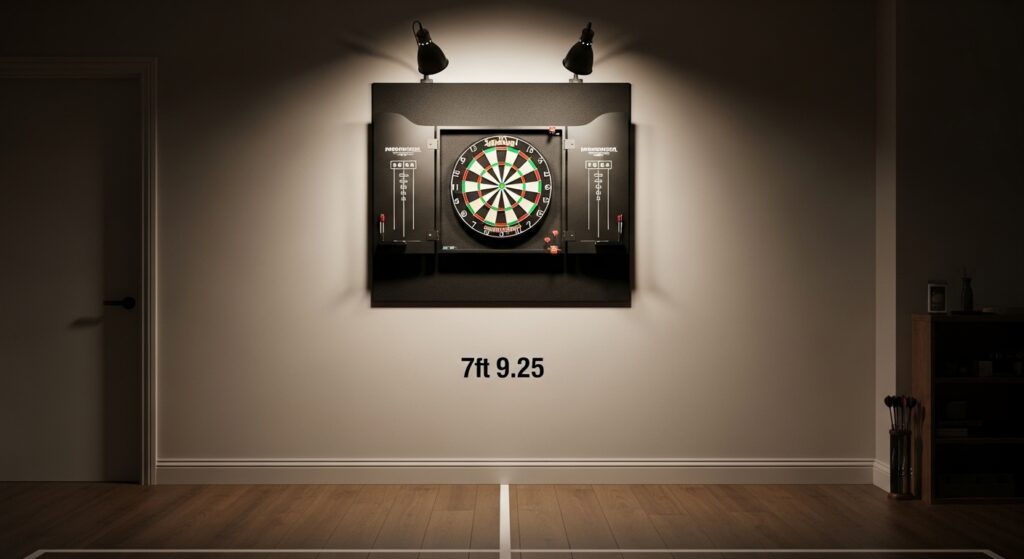
How to Measure Dartboard Distance Accurately
It sounds easy 2.37meters from the board to the throw line but it’s easy to mess up if you’re not measuring from the right point.
Here’s how to get it right every time:
- Measure from the front surface of the dartboard, not from the wall.
- Place measuring tape along the floor.
- Mark the throw line clearly with masking tape or a dart mat edge.
- If you have a raised oche bar, make sure it aligns exactly with that mark.
If you want to double-check, use the diagonal measurement method:
- From the bullseye to the oche mark on the floor should be 2.93 m.
If those numbers match, your setup is perfectly regulation.
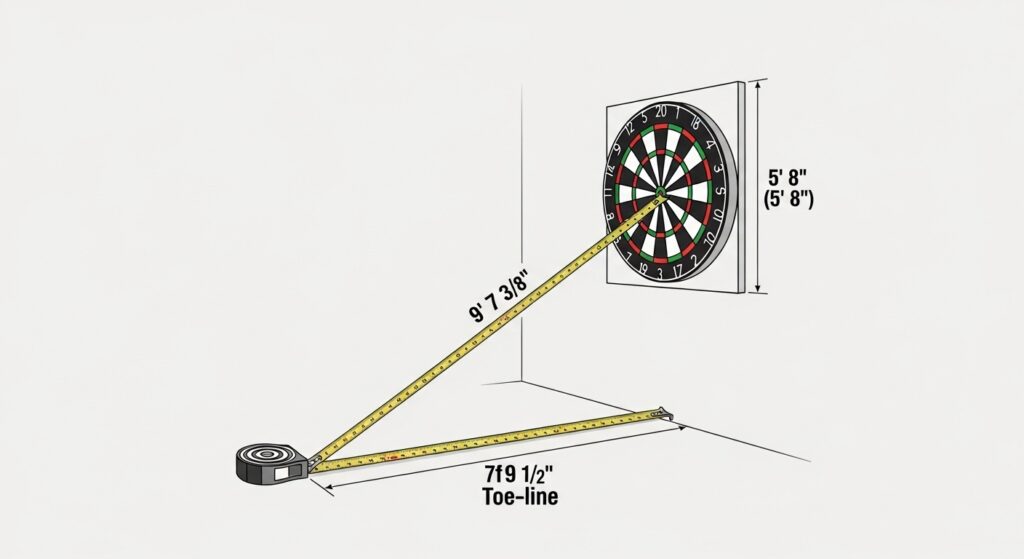
Proper Dartboard Height for Adults and Variants
“Is the dartboard height different for taller or shorter players?” is a question that is occasionally asked. Not at all.
Adults should always stand 1.73 meters from the floor to the bullseye on a dartboard. Play remains fair and consistent because of the sport’s standardisation.
However, in case you are preparing for children or new players who are just learning how to throw, it is okay to reduce the height of the board for a short period of time. Normally, a distance that is somewhere between 1.5 m and 1.6 m is comfortable for beginners.
Electronic vs Bristle Dartboards: Height & Distance
Electronic “soft tips” the dartboards are a little different because of safety and design.
| Type | Height (Meters) | Distance (Meters) | Notes |
| Bristle (Steel-tip) | 1.73 | 2.37 | Regulation standard |
| Electronic (Soft-tip) | 1.78 | 2.44 | Common in Japan & US soft-tip leagues |
Producers typically supply a setup manual. So, verify it once more yourself before making your holes in the wall.
In case you use both soft-tip and steel-tip darts alternately, it would be wise to have a wall mount that can change the height by a few centimeters.
Bristle Dartboard Setup Guide:
- Mark the center point “1.73m from the floor”.
- Attach the mounting bracket securely.
- Hang the board, ensuring the 20segment is at the top.
- Measure 2.37m from the board’s face for the throw line.
- Double check diagonal distance “2.93m”.
Optional: Rotate the board every week or two to distribute wear. The number ring should be removable for this reason.
Lighting Your Dartboard Setup
Lighting is underrated. You can have a perfect board and still feel off if the lighting throws shadows.
Try this:
- Above the board, install an LED strip or ring light.
- Aim for even, gentle lighting that is free of glare.
- Steer clear of ceiling spotlights behind you as they create long shadows.
Some pros use dedicated dartboard light rings that attach directly around the board’s edge. They highlight every segment evenly.

You’ve got the basics: the dartboard height is set, the throw line’s marked, and the wall looks decent. Now comes the part that makes your home setup feel dialed in — the small tweaks, the setup details, the “oh that’s why it feels different at home” kind of stuff.
Let’s keep it real and practical.
Dart Game Setup Instructions
You’ve probably thrown a few darts before, maybe even have a routine. But when you’re setting up a proper space, it’s worth following a consistent dart game setup process. Here’s the quick rundown I give to anyone new in my group:
- Check the board height again 1.73m from the floor to the bullseye. Even a small shift can mess with your muscle memory.
- Mark your oche (throw line) 2.37m out, measured from the front of the board.
- Clear your space; you’ll need three meters of open space behind the oche and roughly one metre on each side.
- Lighting check no glare, no shadows, no flicker.
- Keep spares flights, shafts, and darts nearby.
That’s the whole dart game setup instruction set in plain English. Doesn’t need to be overthought.
Dartboard Height and Distance in Meters
Let’s consolidate everything we’ve been throwing around into one table for reference. Metric only, since that’s the standard you asked for:
| Setup Component | Measurement (Meters) | Description |
| Dartboard Height | 1.73 m | Floor to bullseye |
| Throwing Distance | 2.37 m | Front of board to oche |
| Diagonal (Cross Check) | 2.93 m | Bullseye to oche mark |
| Electronic Board Height | 1.78 m | Soft-tip standard |
| Beginner Height | 1.5–1.6 m | For kids or training setups |
Most boards include mounting kits with metric markings, but I’ve seen plenty labeled only in inches. Double-check conversions before drilling.

Professional Dartboard Measurements
The professional dartboard measurements don’t vary much across tournaments. The World Darts Federation (WDF) and Professional Darts Corporation (PDC) follow the same numbers we’ve talked about.
The only variations you’ll find:
- Soft-tip darts (mostly Japan/US) use slightly longer oche distances.
- Practice setups sometimes shorten distance for tight spaces.
Otherwise, your home setup at 1.73 m and 2.37 m is exactly what the pros use.
That means your practice shots translate perfectly to pub or competition play.
Common Setup Issues (and Fixes)
Even with all the measurements right, something can still feel off. I’ve had that moment too — when your throw just doesn’t “land” right, even though you swear it’s measured perfectly. Usually, it’s one of these:
1. The Board Is Not Flat
Not even walls are always straight. A spirit level should be used in both vertical and horizontal directions. If your alignment is off by just a few degrees, the darts won’t cling properly.
2. The Floor Slopes
Old houses and basements love uneven floors. Measure the height again from where you stand at the oche. It might differ by a centimeter or two.
3. Lighting Glare
Try turning off overhead lighting and test with a side light. Shadows can trick your eyes about where the segments are.
4. Loose Mounting
If your dartboard wobbles even slightly, it’ll affect your throw rhythm. Use wall anchors or re-tighten your bracket.
Dartboard Positioning for Beginners (Revisited)
In case you are a complete beginner or if you are training someone, the location of the dartboard in the room is almost as important as the height.
Many people put their dartboard where it fits in the smallest part of their room. Don’t do that, a dartboard must not be less than 1.5 meters from the walls and furniture on each side. This ensures there is enough space for an arm movement and a safe return.
Moreover, try to place a dartboard in such a way that the light comes from the top, not the back if it is possible at all. The segments look more refined, and it is easier to see them.
Home Dart Setup Ideas
Once your measurements are right, make the setup yours.
Here are a few home dart setup ideas that make a big difference:
- Add a framed scoreboard: next to the board (chalk or dry-erase).
- Use a dart mat: that doubles as oche marker and floor protection.
- Install LED backlighting: behind the board for a soft glow.
- To finish the mood: hang shelves, trophies, or pub signs close by.
- To reduce impact noise: use cork tiles or acoustic panels.
A garage or spare room can be turned into a professional-level nook with an LED ring and mounted dartboard on a simple wooden backdrop.
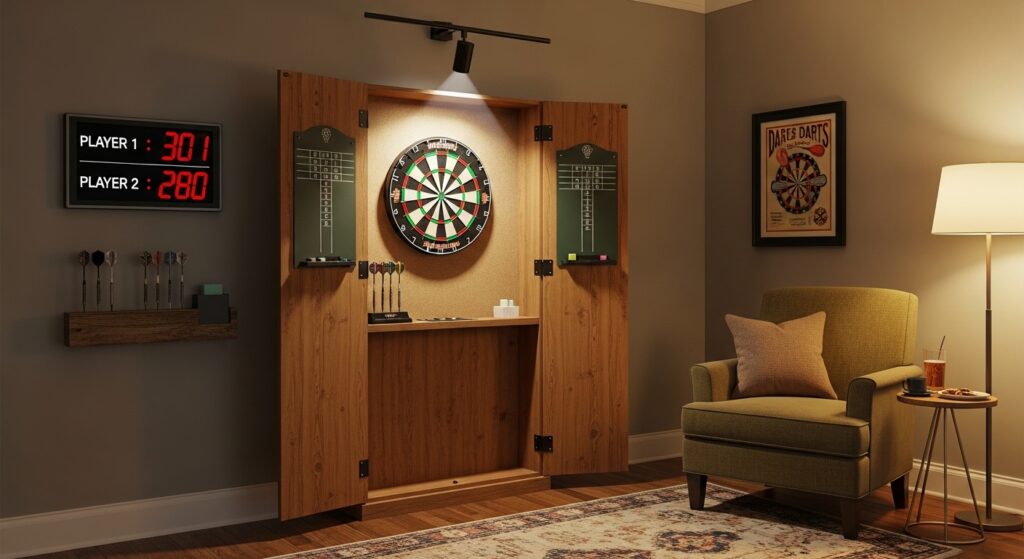
Correct Height for Wall-Mounted Dartboard
Every now and then someone asks if wall thickness or mount type changes the correct height for a wall-mounted dartboard. Nope. It’s still 1.73 m from floor to bullseye — that’s measured from the actual floor surface, not from the baseboard or carpet pile.
If your wall is textured or uneven, mount a backing board first to get a flat surface, then mount the dartboard on that.
Dartboard Height for Soft Tip Darts
If you’re playing with electronic boards (soft-tip darts), keep this in mind:
- Height: 1.78 meters from floor to bullseye
- Throw line: 2.44 meters
Those few centimeters can feel weird if you switch between bristle and soft-tip boards.
If you play both styles, it’s worth marking two oche lines with tape in different colors.
Wall and Floor Setup for Real Practice
For long-term use, think beyond the board.
- Wall Protection: Foam rings, cork, or thick felt.
- Flooring: Use a dart mat or low-pile carpet, protects darts that fall and keeps your stance stable.
- Soundproofing: Mount the board on rubber washers to reduce vibration.
When I first set mine up in an apartment, the vibration noise was brutal. A few felt pads behind the mounting bracket fixed it instantly.
Small Adjustments That Changes Everything
Sometimes a few adjustments are all you need:
- To check for comfort, shift your position half a foot forward or backward.
- Try slightly raising your dartboard lighting angle.
- Add a small riser under your front foot if the floor slopes.
- Recheck your board rotation — the 20 segment should be at the very top, dead center above the bullseye.
Tiny changes like that often make your throw feel “right” again after hours of off-target shots.
Official Dart Board Height and Throw Line
Let’s just lock this one in your head, once and for all:
- Official dart board height: 1.73 meters (floor to bullseye)
- Official throw line (oche): 2.37 meters (front of board to line)
- Diagonal check: 2.93 meters
If you ever get confused, remember that triangle — height, distance, diagonal. It never lies.

Dartboard Rules and Setup (Quick Check)
Some quick rules to make sure your dartboard setup follows proper standards:
| Element | Standard | Notes |
| Height | 1.73 m | From floor to bullseye |
| Oche Distance | 2.37 m | Front of board to throw line |
| Board Type | Bristle | Official tournament type |
| Number 20 | Top-center | Directly above bullseye |
| Surround Area | 1.5 m clearance | On all sides |
| Lighting | Even, non-glare | No shadows on segments |
No one’s going to fine you for breaking these rules at home, but getting them right means your practice will actually translate to real matches.
Professional Dartboard Measurements and Layout
You can perform a quick room check to see if your setup adheres to expert layouts:
- Ceiling height: 2.1 meters or higher is ideal.
- Floor space: 3 meters back from the board, 1.5 meters on each side.
- Board center alignment: Bullseye straight ahead, no side angle.
- Lighting: 1000 from 1500 lumens LED ring or overhead diffuser.
That’s basically what a small club or tournament booth uses.
DIY Home Dart Setup Ideas
You don’t need to spend a ton to make your dart setup look and feel good. A few practical ideas that cost almost nothing:
- Use reclaimed wood or an old door panel as a backing wall.
- Mount LED strips around the border for a warm glow.
- Print and frame a scoreboard template instead of buying one.
- Use cork tiles behind the board for both protection and style.
- Mount everything on a plywood panel that rests against the wall if you want it to be mobile.
It all boils down to comfort and consistency. Once you have the dartboard height just right, all you need to do is make it feel like your spot.
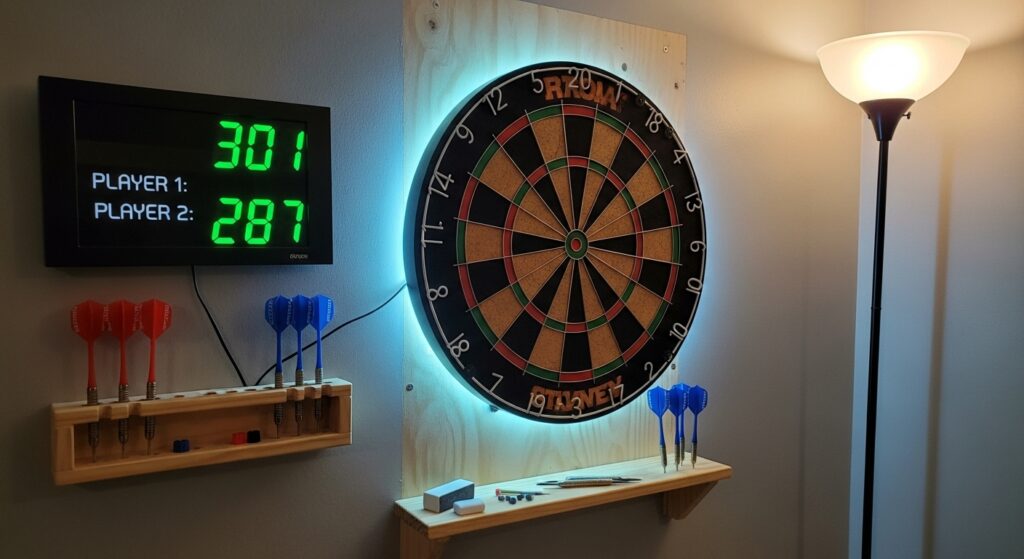
Troubleshooting Setup Problems
Let’s say something feels off, the throw feels strange, darts bounce out, or your scores dip even though you’re hitting well. Before you blame your form, check this quick table:
| Problem | Likely Cause | Quick Fix |
| Darts bounce out | Board too dry / wall angle off | Rotate board, moisten bristles slightly |
| Throws feel short | Board too low | Recheck bullseye height |
| Lighting glare | Overhead light reflection | Add side lighting or diffuser |
| Darts drift sideways | Uneven wall or slope | Check with level tool |
| Oche feels far | Measured from wall, not board | Re-measure from board face |
Quick Word on Maintenance
Once the setup’s perfect, keep it that way:
- Rotate your board weekly.
- Keep darts sharp but not needle like.
- Keep your board out of places with a lot of moisture or direct sunlight.
- Every few sessions, lightly wipe your board with a dry cloth.
Every few weeks, hoover or blow dust out of the holes if you use an electronic dartboard. In fact, it adds months to the board’s lifespan.
Oche Distance Tips
If you don’t want to tape the floor every time, use an oche mat with printed distances or a fixed toe line bar.
A few players I know even use a short wooden plank as a toe guide, works fine, feels official. And remember, when you’re measuring that 2.37 m oche line, make sure the tape measure runs straight from the board’s face, not at an angle.
5 FAQs
1. How high should I hang a dart board?
For standard steel tip darts, hang it so the bullseye is 1.73meters (5 feet 8 inches) from the floor. That’s the same regulation height used in professional tournaments.
2. What is the correct distance to stand from a dartboard?
Stand 2.37 meters from the front of the dartboard. That’s the official oche distance for steel-tip play.
3. What are the height and distance of an electronic dartboard?
Height for an electronic (soft-tip) dartboard is 1.78 meters from the ground to the bullseye and the throwing distance is 2.44 meters.
4. Can I hang a dartboard on drywall?
Yes, but use wall anchors or a backing board to protect the wall and distribute weight. Never screw directly into thin drywall — it won’t hold.
5. Do I need a surround for my dartboard?
Although not required, it is strongly advised. A backboard or surround ring gives your setup a neat, polished appearance while shielding your wall from stray darts.
Let It Settle
That’s pretty much it. No big finale needed. You measure once, you play thousands of throws, and eventually the board becomes part of the room, something you don’t even think about.
The key is consistency. Once your dart board height and distance are locked in, you’re free to just throw, learn ,adjust and throw again.
And yeah, you’ll probably still hit the wall a few times. That’s fine. Every player does. Just means you’re human and you’re playing for real.

I’m Daniel Moore, and I live for the thrill of the game. Get energetic live commentary, detailed match analysis, data-backed betting predictions, and official team rankings right here.


